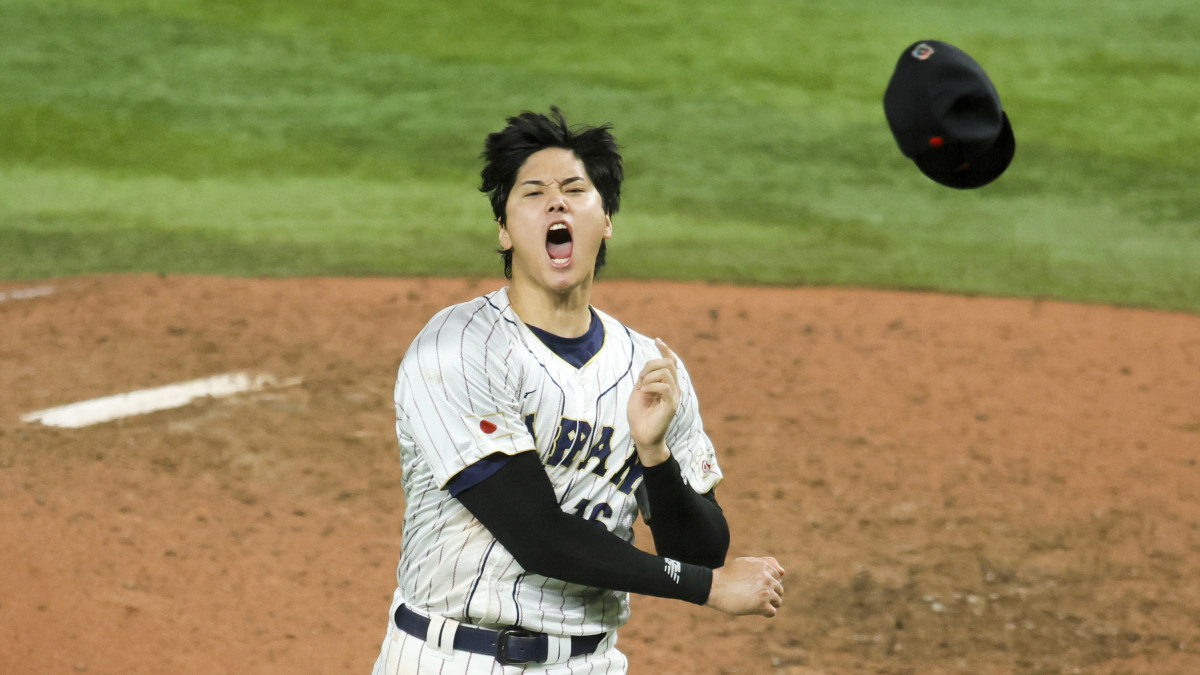SI:AM | Ohtani and Trout Combine for Memorable World Baseball Classic Finale
Good morning, I’m Dan Gartland. Do we really have to go back to spring training games after that?
In today’s SI:AM:
🇯🇵 The WBC’s fairy-tale ending
If you're reading this on SI.com, you can sign up to get this free newsletter in your inbox each weekday at SI.com/newsletters.
Trout vs. Ohtani lived up to the hype
It had to come down to that, didn’t it? Bottom of the ninth, two outs, full count, Team USA trailing Japan 3–2. The two best players in the game, two of the best players ever—and teammates, no less—going head to head with a championship on the line.
And then Shohei Ohtani struck out Mike Trout with one of the nastiest sliders you’ll ever see to give Japan its third World Baseball Classic championship.
Ohtani’s reaction to striking out Trout was unlike anything we’ve seen from him in an Angels uniform. He spiked his glove, then threw his hat, all while screaming at the top of his lungs. The tournament meant just as much to Trout, who has repeatedly said how much he enjoyed participating. He called it “probably the funnest 10 days I've ever had. It reminded me of travel ball, when you were a kid. It brought back a lot of good memories.” He’s already said that he plans to play in the 2026 tournament.
Watching Ohtani and Trout excel under the bright lights was a harsh reminder of how the Angels have inexplicably failed to build a winning team around them that competes in meaningful games like last night’s. But the WBC was also a reminder that the game of baseball is bigger than Major League Baseball.
The tournament introduced us to players like Israel pitcher Shlomo Lipetz, a 44-year-old who in his day job as president of venues at City Winery is in charge of booking concerts across the United States, and 21-year-old Nicaragua pitcher Duque Hebbert, who signed his first MLB contract after striking out Juan Soto, Julio Rodríguez and Manny Machado in the same inning. It also exposed American fans to the biggest stars in Japan. You may have read about Roki Sasaki’s unreal 19-strikeout perfect game last season and the eight perfect innings he threw in his next start, but actually watching him against a Mexico lineup full of MLB hitters was special.
The WBC took a big leap forward this year. Getting Trout—and Mookie Betts, Trea Turner and others—to participate gave the U.S. an unprecedentedly fearsome lineup that made the tournament seem more legitimate in the eyes of many American fans. The glaring weakness from a U.S. perspective, though, was the lack of star pitchers. Japan got far more of its superstars to commit to playing in the tournament, particularly pitchers like Ohtani, Sasaki and Yu Darvish. The U.S. didn’t get anyone of that caliber to pitch, as Tom Verducci explains:
The best pitchers in Japan competed to get on Samurai Japan’s roster. The USA could not get even one of the 14 U.S.-born pitchers who received a vote for the Cy Young awards last season to throw a pitch for it.
The first four pitchers [manager Mark] DeRosa used in the championship game combined in their careers for a 114–120 record, no All-Star games, no postseason wins and no fastballs with above-average velocity.
It makes sense that pitchers, who are more prone to injury than position players, would be hesitant to play high-pressure games for a team other than the one that pays their salary. But after this year’s thrilling tournament and Trout’s repeated praise for how much fun he was having, maybe more top players will want to be on the team in 2026.
The WBC was a curiosity when it was introduced in 2006. Only 16,000 people saw Japan’s first game against China in the Tokyo Dome. The U.S.-Canada game at Chase Field in Phoenix attracted only 17,000. But interest has grown with each iteration of the tournament and should continue to increase as players such as Trout advocate for the best of the best to compete. The only thing left to fix—besides the participation of top U.S. pitchers—is the tournament’s timing. Rather than compete against March Madness in the spring, when pitchers are still working to get to full strength, play the tournament in place of an All-Star break every four years when all eyes will be on baseball. I can’t think of a better way to grow the game.
The best of Sports Illustrated

- Today’s Daily Cover by Gwendolyn Oxenham is a profile of top NWSL draft pick Alyssa Thompson, who is not only able to hang with top boys players but excel against them.
- Stephanie Apstein has a closer look at the Ohtani-Trout showdown.
- Pat Forde ranked all the teams left standing in the men’s NCAA tournament.
- Chris Mannix is tired of all the arguments over the NBA’s MVP award.
- Matt Verderame and Gilberto Manzano put together a ranking of the best backup quarterbacks in the NFL.
- Chris Herring pays tribute to Knicks great Willis Reed, who died yesterday at 80.
- Chargers running back Austin Ekeler explained why he asked for a trade.
- Ben Roethlisberger says the 49ers asked him about coming out of retirement.
The top five...
… stats and highlights from U.S.-Japan:
5. Proof that Ohtani’s slider to Trout was virtually unhittable.
4. Munetaka Murakami’s upper-deck blast in the second inning.
3. Trea Turner’s fifth home run of the WBC. That’s tied for the most by one player in a single WBC.
2. This fact about Trout’s strikeout against Ohtani: Only 24 times in 6,174 (0.3%) MLB plate appearances has Trout swung and missed at three pitches.
1. The Japanese broadcast of Ohtani’s strikeout.
SIQ
On this day in 1958, despite his Seattle team losing to Kentucky in the national championship game, future NBA Hall of Famer Elgin Baylor was named the men’s NCAA tournament’s Most Outstanding Player. Since 1966, only one player has won the men’s MOP award while playing for a team that did not win the tournament. Who was it?
- Larry Bird
- Derrick Rose
- Gordon Hayward
- Hakeem Olajuwon
Yesterday’s SIQ: On this day in 1978, which MLB team became the second to fire its manager during spring training when it dismissed Alvin Dark just weeks before Opening Day?
- A’s
- Phillies
- Mets
- Padres
Answer: Padres. Dark, a baseball lifer who’d won a World Series as a player with the Giants in 1954 and as a manager with the A’s in ’74, was fired over what San Diego executive vice president Ballard Smith said was an inability to “communicate effectively with his players, coaching staff and those of us in the front office.”
Dark had taken over in the middle of the previous season after the Padres fired John McNamara and went 48–65. It was his fifth stop as a big league manager. Though he had been successful as a manager previously—in addition to his championship with Oakland, he also won the National League pennant managing the Giants in 1962—he rubbed players the wrong way in San Diego. “Players had complained that he called pitches from the bench and changed the lineup often,” UPI reported.
Dark was replaced by pitching coach Roger Craig, who went on to lead the Padres to their first winning season in their 10th year in the league. Dark never managed another team.
Dark joined Phil Cavarretta as the only big league managers to be fired during spring training. Cavarretta was fired by the Cubs in 1954 after he told owner Phil Wrigley that he thought the team would finish in the bottom half of the league. (Chicago went 64–90 that year, second worst in the NL.) An equally strange tale is that of Eddie Sawyer, the Phillies manager who quit after losing on Opening Day in ’60. Sawyer, whose Phillies had gone 64–90 in the previous season, told reporters, “I am 49 years old and want to live to be 50.”
